
Ebook: Essentials of Cloud Computing : A Holistic, Cloud-Native Perspective
- Genre: Computers // System Administration
- Year: 2023
- Publisher: Springer International Publishing
- Edition: 2
- Language: English
- epub
Numerous advancements are being brought in and incorporated into the cloud domain with the aim of realizing a trove of deeper and decisive automations.
Rather than discussing the cloud paradigm in isolation, this fully updated text examines how cloud computing can work collaboratively with other computing models to meet the needs of evolving trends.This multi-dimensional approach encompasses the challenges of fulfilling the storage requirements of big data, the use of the cloud as a remote server for Internet of Things and sensor networks, and an investigation of how cloud computing is interlinked with other established computing phenomenon such as edge computing. New chapters illustrate the distinct ideals of the cloud-native computing, proclaimed as the next-generation cloud computing paradigm.
Cloud infrastructure modules and platforms play a pivotal role for producing and running state-of-the-art digital applications. Cloud-based data analytical and Artificial Intelligence (AI) frameworks come handy in extracting actionable insights out of digital data. That is, clouds contribute immensely to fulfilling the ideals of digital intelligence. Highly scalable, reliable, composable and observable applications can be realized and run on cloud runtime environments. All kinds of enterprise-scale business workloads are being meticulously modernized and migrated to cloud arena to reap all the originally expressed benefits of cloud computing. The Internet of Things (IoT) sensors and devices are directly or indirectly integrated with cloud storages and analytics tools to enable knowledge discovery. The knowledge discovered then gets disseminated to IoT products, solutions and services to deliver value to their users, operators and owners.
Topics and features:
Includes learning objectives, motivating questions, and self-test exercises
Introduces the underlying concepts, fundamental features, and key technological foundations of cloud computing
Examines how enterprise networking and cloud networking can work together to achieve business goals
Reviews the different types of cloud storage available to address the evolution of data and the need for digitization
Discusses the challenges and approaches to implementing cloud governance, security, and the hot topic of cloud management
Describes the details of cloud migration, the crucial role of monitoring in optimizing the cloud, and the basics of disaster recovery using cloud infrastructure
This technically rigorous, yet simple-to-follow textbook is an ideal resource for graduate courses on cloud computing. Professional software developers and cloud architects will also find the work to be an invaluable reference.
Rather than discussing the cloud paradigm in isolation, this fully updated text examines how cloud computing can work collaboratively with other computing models to meet the needs of evolving trends.This multi-dimensional approach encompasses the challenges of fulfilling the storage requirements of big data, the use of the cloud as a remote server for Internet of Things and sensor networks, and an investigation of how cloud computing is interlinked with other established computing phenomenon such as edge computing. New chapters illustrate the distinct ideals of the cloud-native computing, proclaimed as the next-generation cloud computing paradigm.
Cloud infrastructure modules and platforms play a pivotal role for producing and running state-of-the-art digital applications. Cloud-based data analytical and Artificial Intelligence (AI) frameworks come handy in extracting actionable insights out of digital data. That is, clouds contribute immensely to fulfilling the ideals of digital intelligence. Highly scalable, reliable, composable and observable applications can be realized and run on cloud runtime environments. All kinds of enterprise-scale business workloads are being meticulously modernized and migrated to cloud arena to reap all the originally expressed benefits of cloud computing. The Internet of Things (IoT) sensors and devices are directly or indirectly integrated with cloud storages and analytics tools to enable knowledge discovery. The knowledge discovered then gets disseminated to IoT products, solutions and services to deliver value to their users, operators and owners.
Topics and features:
Includes learning objectives, motivating questions, and self-test exercises
Introduces the underlying concepts, fundamental features, and key technological foundations of cloud computing
Examines how enterprise networking and cloud networking can work together to achieve business goals
Reviews the different types of cloud storage available to address the evolution of data and the need for digitization
Discusses the challenges and approaches to implementing cloud governance, security, and the hot topic of cloud management
Describes the details of cloud migration, the crucial role of monitoring in optimizing the cloud, and the basics of disaster recovery using cloud infrastructure
This technically rigorous, yet simple-to-follow textbook is an ideal resource for graduate courses on cloud computing. Professional software developers and cloud architects will also find the work to be an invaluable reference.
Download the book Essentials of Cloud Computing : A Holistic, Cloud-Native Perspective for free or read online
Continue reading on any device:

Last viewed books
Related books
{related-news}
Comments (0)